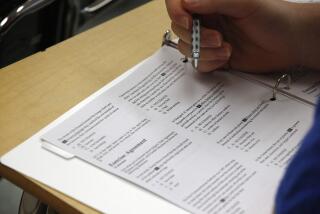Why kids take physical fitness tests at school
Remember that test you had to take in fifth grade, when you stretched your legs under a table and your arms over it, reaching as far as possible?
Yeah, kids are still doing a version of that.
It’s called the “back-saver sit and reach,” and it’s part of the annual physical fitness test the state administers to students to test whether children are healthy enough or need improvement in the areas of aerobic capacity, muscle and skeletal function and body composition.
The back-saver sit and reach is an optional item in the six-part test, meant to measure flexibility—students stretch out one leg as far as they can and reach out, to measure hamstring flexibility on either side. One of the most common complaints adults have is lower back pain, and the sit-and-reach measures hamstring flexibility, said James Morrow, a professor of kinesiology, health promotion and recreation at the University of North Texas.
Other tests can include a run, a body mass index measurement, push-ups and trunk lifts.
On individual tests in the 2014-2015 school year, California students did well, with a majority in the healthy fitness range. In California, about 1.3 million students took the fitness test at least in part. Fifth-, seventh- and ninth-grade students take the tests, and between 73% and 85% of students are in the healthy flexibility zone.
But a much smaller percentage of students — between 26% and 37% — who took all six tests achieved a healthy fitness zone score in all of them. These rates are similar to past years.
The organization that develops the test, the Cooper Institute, says the tests are “not intended to be predictors of disease or illness,” spokeswoman Claire Leigh Kinzy said in an email. “A score in the Healthy Fitness Zone represents the level of fitness needed for good overall health and is thought to reduce risk from the potential health threats that can arise from a lack of fitness.”
American students have taken fitness tests since the 1950s, when the country worried that not enough youth were service-ready after World War II, Morrow said. In the 1970s, educators began to use the tests more as a health measurement, he said.
NEWSLETTER: Get essential California headlines delivered daily >>
The tests of the 1950s included some of the same ones kids perform today, like pull-ups and running. They also included some that have been lost, like a softball throw.
California schools began administering physical fitness tests in 1976, according to a news release from the state’s Department of Education. Those tests have taken different forms.
Many of the potential problems that the current tests are supposed to warn against — cardiovascular illness, back problems and diabetes, to name a few — may not affect children until later in life, Morrow said. But testing them at a young age teaches the students what exercises to associate with different kinds of health, and why those exercises are important.
Reach Sonali Kohli on Twitter @Sonali_Kohli or by email at Sonali.Kohli@latimes.com.
More to Read
Start your day right
Sign up for Essential California for news, features and recommendations from the L.A. Times and beyond in your inbox six days a week.
You may occasionally receive promotional content from the Los Angeles Times.







